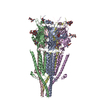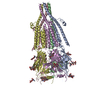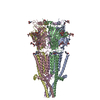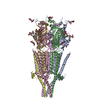+ Open data
Open data
- Basic information
Basic information
| Entry | Database: PDB / ID: 6w1m | |||||||||
|---|---|---|---|---|---|---|---|---|---|---|
| Title | Cryo-EM structure of 5HT3A receptor in presence of Ondansetron | |||||||||
 Components Components | 5-hydroxytryptamine receptor 3A | |||||||||
 Keywords Keywords | TRANSPORT PROTEIN | |||||||||
| Function / homology |  Function and homology information Function and homology informationNeurotransmitter receptors and postsynaptic signal transmission / serotonin-gated cation-selective signaling pathway / serotonin-activated cation-selective channel complex / serotonin-gated monoatomic cation channel activity / serotonin receptor signaling pathway / serotonin binding / inorganic cation transmembrane transport / cleavage furrow / extracellular ligand-gated monoatomic ion channel activity / ligand-gated monoatomic ion channel activity involved in regulation of presynaptic membrane potential ...Neurotransmitter receptors and postsynaptic signal transmission / serotonin-gated cation-selective signaling pathway / serotonin-activated cation-selective channel complex / serotonin-gated monoatomic cation channel activity / serotonin receptor signaling pathway / serotonin binding / inorganic cation transmembrane transport / cleavage furrow / extracellular ligand-gated monoatomic ion channel activity / ligand-gated monoatomic ion channel activity involved in regulation of presynaptic membrane potential / transmembrane signaling receptor activity / postsynaptic membrane / identical protein binding Similarity search - Function | |||||||||
| Biological species |  | |||||||||
| Method | ELECTRON MICROSCOPY / single particle reconstruction / cryo EM / Resolution: 3.06 Å | |||||||||
 Authors Authors | Basak, S. / Chakrapani, S. | |||||||||
| Funding support |  United States, 2items United States, 2items
| |||||||||
 Citation Citation |  Journal: Elife / Year: 2020 Journal: Elife / Year: 2020Title: High-resolution structures of multiple 5-HTR-setron complexes reveal a novel mechanism of competitive inhibition. Authors: Sandip Basak / Arvind Kumar / Steven Ramsey / Eric Gibbs / Abhijeet Kapoor / Marta Filizola / Sudha Chakrapani /  Abstract: Serotonin receptors (5-HTR) play a crucial role in regulating gut movement, and are the principal target of setrons, a class of high-affinity competitive antagonists, used in the management of nausea ...Serotonin receptors (5-HTR) play a crucial role in regulating gut movement, and are the principal target of setrons, a class of high-affinity competitive antagonists, used in the management of nausea and vomiting associated with radiation and chemotherapies. Structural insights into setron-binding poses and their inhibitory mechanisms are just beginning to emerge. Here, we present high-resolution cryo-EM structures of full-length 5-HTR in complex with palonosetron, ondansetron, and alosetron. Molecular dynamic simulations of these structures embedded in a fully-hydrated lipid environment assessed the stability of ligand-binding poses and drug-target interactions over time. Together with simulation results of apo- and serotonin-bound 5-HTR, the study reveals a distinct interaction fingerprint between the various setrons and binding-pocket residues that may underlie their diverse affinities. In addition, varying degrees of conformational change in the setron-5-HTR structures, throughout the channel and particularly along the channel activation pathway, suggests a novel mechanism of competitive inhibition. #1:  Journal: Nat Commun / Year: 2019 Journal: Nat Commun / Year: 2019Title: Molecular mechanism of setron-mediated inhibition of full-length 5-HT receptor. Authors: Sandip Basak / Yvonne Gicheru / Abhijeet Kapoor / Megan L Mayer / Marta Filizola / Sudha Chakrapani /  Abstract: Serotonin receptor (5-HTR) is the most common therapeutic target to manage the nausea and vomiting during cancer therapies and in the treatment of irritable bowel syndrome. Setrons, a class of ...Serotonin receptor (5-HTR) is the most common therapeutic target to manage the nausea and vomiting during cancer therapies and in the treatment of irritable bowel syndrome. Setrons, a class of competitive antagonists, cause functional inhibition of 5-HTR in the gastrointestinal tract and brainstem, acting as effective anti-emetic agents. Despite their prevalent use, the molecular mechanisms underlying setron binding and inhibition of 5-HTR are not fully understood. Here, we present the structure of granisetron-bound full-length 5-HTR solved by single-particle cryo-electron microscopy to 2.92 Å resolution. The reconstruction reveals the orientation of granisetron in the orthosteric site with unambiguous density for interacting sidechains. Molecular dynamics simulations and electrophysiology confirm the granisetron binding orientation and the residues central for ligand recognition. Comparison of granisetron-bound 5-HTR with the apo and serotonin-bound structures, reveals key insights into the mechanism underlying 5-HTR inhibition. | |||||||||
| History |
|
- Structure visualization
Structure visualization
| Movie |
 Movie viewer Movie viewer |
|---|---|
| Structure viewer | Molecule:  Molmil Molmil Jmol/JSmol Jmol/JSmol |
- Downloads & links
Downloads & links
- Download
Download
| PDBx/mmCIF format |  6w1m.cif.gz 6w1m.cif.gz | 371.4 KB | Display |  PDBx/mmCIF format PDBx/mmCIF format |
|---|---|---|---|---|
| PDB format |  pdb6w1m.ent.gz pdb6w1m.ent.gz | 308.2 KB | Display |  PDB format PDB format |
| PDBx/mmJSON format |  6w1m.json.gz 6w1m.json.gz | Tree view |  PDBx/mmJSON format PDBx/mmJSON format | |
| Others |  Other downloads Other downloads |
-Validation report
| Summary document |  6w1m_validation.pdf.gz 6w1m_validation.pdf.gz | 2.2 MB | Display |  wwPDB validaton report wwPDB validaton report |
|---|---|---|---|---|
| Full document |  6w1m_full_validation.pdf.gz 6w1m_full_validation.pdf.gz | 2.3 MB | Display | |
| Data in XML |  6w1m_validation.xml.gz 6w1m_validation.xml.gz | 63.7 KB | Display | |
| Data in CIF |  6w1m_validation.cif.gz 6w1m_validation.cif.gz | 93.3 KB | Display | |
| Arichive directory |  https://data.pdbj.org/pub/pdb/validation_reports/w1/6w1m https://data.pdbj.org/pub/pdb/validation_reports/w1/6w1m ftp://data.pdbj.org/pub/pdb/validation_reports/w1/6w1m ftp://data.pdbj.org/pub/pdb/validation_reports/w1/6w1m | HTTPS FTP |
-Related structure data
| Related structure data |  21512MC  6w1jC  6w1yC M: map data used to model this data C: citing same article ( |
|---|---|
| Similar structure data |
- Links
Links
- Assembly
Assembly
| Deposited unit | 
|
|---|---|
| 1 |
|
- Components
Components
| #1: Protein | Mass: 52042.121 Da / Num. of mol.: 5 Source method: isolated from a genetically manipulated source Source: (gene. exp.)   #2: Polysaccharide | 2-acetamido-2-deoxy-beta-D-glucopyranose-(4-4)-2-acetamido-2-deoxy-beta-D-glucopyranose Type: oligosaccharide / Mass: 424.401 Da / Num. of mol.: 5 Source method: isolated from a genetically manipulated source #3: Polysaccharide | beta-D-mannopyranose-(1-4)-2-acetamido-2-deoxy-beta-D-glucopyranose-(1-4)-2-acetamido-2-deoxy-beta- ...beta-D-mannopyranose-(1-4)-2-acetamido-2-deoxy-beta-D-glucopyranose-(1-4)-2-acetamido-2-deoxy-beta-D-glucopyranose Source method: isolated from a genetically manipulated source #4: Polysaccharide | 2-acetamido-2-deoxy-beta-D-glucopyranose-(1-4)-2-acetamido-2-deoxy-beta-D-glucopyranose Source method: isolated from a genetically manipulated source #5: Chemical | ChemComp-S87 / Has ligand of interest | Y | Has protein modification | Y | |
|---|
-Experimental details
-Experiment
| Experiment | Method: ELECTRON MICROSCOPY |
|---|---|
| EM experiment | Aggregation state: PARTICLE / 3D reconstruction method: single particle reconstruction |
- Sample preparation
Sample preparation
| Component | Name: Serotonin receptor / Type: COMPLEX / Entity ID: #1 / Source: RECOMBINANT |
|---|---|
| Molecular weight | Value: 0.27 MDa / Experimental value: NO |
| Source (natural) | Organism:  |
| Source (recombinant) | Organism:  |
| Buffer solution | pH: 8 |
| Specimen | Conc.: 3 mg/ml / Embedding applied: NO / Shadowing applied: NO / Staining applied: NO / Vitrification applied: YES |
| Specimen support | Grid type: Quantifoil R1.2/1.3 |
| Vitrification | Instrument: FEI VITROBOT MARK I / Cryogen name: ETHANE / Humidity: 100 % / Chamber temperature: 277 K / Details: blot for 2.5 seconds |
- Electron microscopy imaging
Electron microscopy imaging
| Experimental equipment |  Model: Titan Krios / Image courtesy: FEI Company |
|---|---|
| Microscopy | Model: FEI TITAN KRIOS |
| Electron gun | Electron source:  FIELD EMISSION GUN / Accelerating voltage: 300 kV / Illumination mode: FLOOD BEAM FIELD EMISSION GUN / Accelerating voltage: 300 kV / Illumination mode: FLOOD BEAM |
| Electron lens | Mode: BRIGHT FIELD / Nominal magnification: 105000 X / Cs: 2.7 mm / C2 aperture diameter: 70 µm |
| Specimen holder | Cryogen: NITROGEN |
| Image recording | Electron dose: 50 e/Å2 / Detector mode: SUPER-RESOLUTION / Film or detector model: GATAN K3 (6k x 4k) / Num. of real images: 2530 |
| Image scans | Movie frames/image: 30 / Used frames/image: 1-30 |
- Processing
Processing
| Software | Name: PHENIX / Version: 1.13_2998: / Classification: refinement | ||||||||||||||||||||||||||||||||||||
|---|---|---|---|---|---|---|---|---|---|---|---|---|---|---|---|---|---|---|---|---|---|---|---|---|---|---|---|---|---|---|---|---|---|---|---|---|---|
| EM software |
| ||||||||||||||||||||||||||||||||||||
| CTF correction | Type: PHASE FLIPPING AND AMPLITUDE CORRECTION | ||||||||||||||||||||||||||||||||||||
| Particle selection | Num. of particles selected: 449628 | ||||||||||||||||||||||||||||||||||||
| Symmetry | Point symmetry: C5 (5 fold cyclic) | ||||||||||||||||||||||||||||||||||||
| 3D reconstruction | Resolution: 3.06 Å / Resolution method: FSC 0.143 CUT-OFF / Num. of particles: 67333 / Symmetry type: POINT | ||||||||||||||||||||||||||||||||||||
| Atomic model building | B value: 50 / Protocol: OTHER / Space: REAL |
 Movie
Movie Controller
Controller














 PDBj
PDBj



